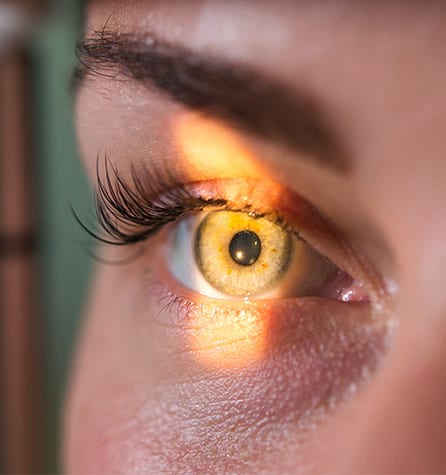Staying Ahead of Eye Disease
Many eye diseases develop without any noticeable symptoms, so an eye exam is the best way to catch diseases early when they’re easier to treat.
In your eye exam, we’ll use our diagnostic equipment to see the earliest warning signs of diseases that may threaten your vision. From there, we can create a personalized treatment plan to manage any identified conditions to help protect your vision.


Common Eye Diseases & Conditions
In your eye exam, we’ll take detailed images of the internal structures of your eyes to allow us to diagnose or track any eye conditions.
It’s important to us that you feel informed and empowered when you visit us, so please ask any questions you have along the way.
Glaucoma
Glaucoma affects around 800,000 Canadians—but half of them don’t know it. Glaucoma can cause serious vision loss before symptoms become noticeable, so it’s important to see your eye doctor regularly. This is especially important if you have certain risk factors, including age (over 60) or a family history of glaucoma.
The first noticeable symptoms are often peripheral vision loss, halos around lights, or eye pain. Depending on the type of glaucoma, treatment in the early stages can be as simple as medicated eye drops to lower the pressure in the eye.
Cataracts eventually happen to just about everyone as they age. They occur when the normally clear lens of the eye becomes cloudy.
Early symptoms can include blurry or foggy vision, decreased night vision, and muted colour vision. In early stages, eyeglasses can help with cataracts, but as the cataracts progress, surgery may be recommended.
Age-Related Macular Degeneration (AMD)
Age-related macular degeneration (AMD) affects the centre of your vision, which you rely on to see faces, drive, and read. AMD is often related to the aging process, and it’s the leading cause of blindness in adults over 55.
AMD doesn’t show symptoms early on, but as it progresses, it can show up as blurriness in your central vision.
The more common form of the condition is called dry AMD. While there’s no treatment, dry AMD can be slowed in its early stages with a healthy lifestyle, vitamin supplements, and smoking cessation. Wet AMD is less common but can have more serious immediate vision consequences. Treatments include medication or laser therapy.
Diabetic Eye Disease
Those with diabetes need to take particular care of their eyes. Uncontrolled blood sugar over time can cause damage to the blood vessels in the retina, potentially causing diabetic retinopathy, which can cause diabetic macular edema.
Learn about our approach to eye care for our diabetic patients.
Conjunctivitis (Pink Eye)
Conjunctivitis is an infection or inflammation of the conjunctiva—the thin membrane covering the whites of your eye and inner eyelid. Conjunctivitis can be caused by bacteria or a virus or can be due to allergies or chemicals.
Signs you may have conjunctivitis include:
- Pink colouring in the whites of one or both eyes
- Itching or burning
- Light sensitivity
- Swollen eyelid
- Sticky, watery, or stringy discharge
- Excessive tearing
Nutrition for Healthy Eyes
Your diet can protect against eye diseases like AMD and cataracts or provide relief from dry eye symptoms. We’re happy to advise you on dietary changes or supplements that can support your vision health.
Some vitamins and minerals that are great for your eyes include:
- Lutein & zeaxanthin may lower your risk of developing cataracts. Find it in dark, leafy greens.
- Vitamin C may lower the risk of developing cataracts and slow the progression of AMD. Find it in citrus, strawberries, and tomatoes.
Omega-3 fatty acids are key to the development of infants’ eyes and retinal function. They can also reduce eye inflammation and support tear function in adults, helping address dry eye symptoms. You can find omega-3s in coldwater fish like salmon and tuna or through the PRN omega-3 supplements we offer at our practice.
Exercise & Your Vision Health
Just as exercise can build strong bones and muscles, boost your energy, and protect against chronic disease, it’s also been shown to promote healthy eyes.
Studies have shown that exercise can even protect against some eye diseases. In one study, people who engaged in moderate exercise were 25% less likely to develop glaucoma than inactive people.
Convenient Location,
Hours To Fit Your Schedule, Direct Billing

Our Address
- 9-1025 Talbot Street
- St. Thomas, ON N5P 0G8
Contact Information
- Phone: 519.633.7803
- Email: [email protected]
Our Hours
- Monday: 8:00 AM – 5:00 PM
- Tuesday: 8:00 AM – 6:00 PM
- Wednesday: 8:00 AM – 6:00 PM
- Thursday: 9:00 AM – 7:00 PM
- Friday: 8:00 AM – 4:00 PM
- Saturday: Closed
- Sunday: Closed
Our Brands

















